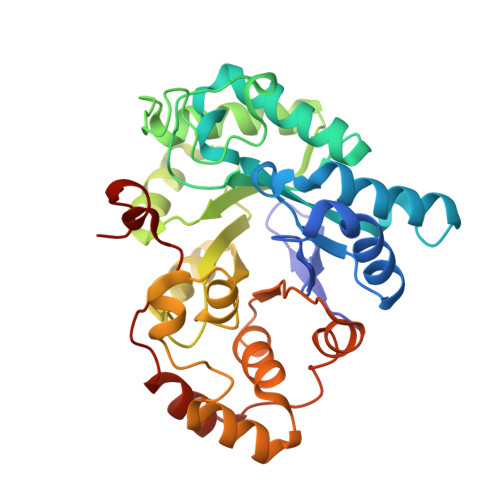Probing the substrate binding site of Candida tenuis xylose reductase (AKR2B5) with site-directed mutagenesis
Kratzer, R., Leitgeb, S., Wilson, D.K., Nidetzky, B.(2006) Biochem J 393: 51-58
- PubMed: 16336198
- DOI: https://doi.org/10.1042/BJ20050831
- Primary Citation of Related Structures:
1Z9A - PubMed Abstract:
Little is known about how substrates bind to CtXR (Candida tenuis xylose reductase; AKR2B5) and other members of the AKR (aldo-keto reductase) protein superfamily. Modelling of xylose into the active site of CtXR suggested that Trp23, Asp50 and Asn309 are the main components of pentose-specific substrate-binding recognition. Kinetic consequences of site-directed substitutions of these residues are reported. The mutants W23F and W23Y catalysed NADH-dependent reduction of xylose with only 4 and 1% of the wild-type efficiency (kcat/K(m)) respectively, but improved the wild-type selectivity for utilization of ketones, relative to xylose, by factors of 156 and 471 respectively. Comparison of multiple sequence alignment with reported specificities of AKR members emphasizes a conserved role of Trp23 in determining aldehyde-versus-ketone substrate selectivity. D50A showed 31 and 18% of the wild-type catalytic-centre activities for xylose reduction and xylitol oxidation respectively, consistent with a decrease in the rates of the chemical steps caused by the mutation, but no change in the apparent substrate binding constants and the pattern of substrate specificities. The 30-fold preference of the wild-type for D-galactose compared with 2-deoxy-D-galactose was lost completely in N309A and N309D mutants. Comparison of the 2.4 A (1 A=0.1 nm) X-ray crystal structure of mutant N309D bound to NAD+ with the previous structure of the wild-type holoenzyme reveals no major structural perturbations. The results suggest that replacement of Asn309 with alanine or aspartic acid disrupts the function of the original side chain in donating a hydrogen atom for bonding with the substrate C-2(R) hydroxy group, thus causing a loss of transition-state stabilization energy of 8-9 kJ/mol.
Organizational Affiliation:
Institute of Biotechnology and Biochemical Engineering, Graz University of Technology, Petersgasse 12/I, A-8010 Graz, Austria.















